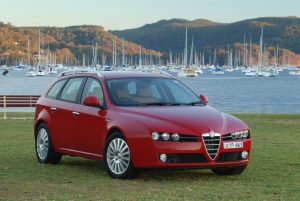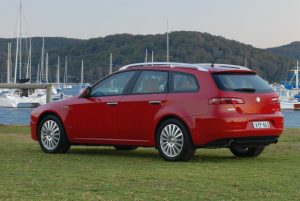Recalls: Alfa Romeo 159 Sportwagon
Overview
Manufacturers, or importers, issue recalls for defects or faults which have the potential to cause injury. Generally, manufacturers will inform the original buyers if their vehicle is subject to a recall and of the steps required to remedy the defect or fault. Please note that the recalls below (if any) are for Australian-delivered vehicles only. Furthermore, the number of recalls should not be taken as an indication of a model’s reliability or its safety more generally.
Recalls: Alfa Romeo 159 Sportwagon
Alfa Romeo 159 Sportwagon V6: stiff brake pedal
In March 2009, a recall was issued for Alfa Romeo 159 Sportwagon vehicles with automatic transmissions and 3.2-litre V6 engines. In these vehicles, a malfunction could cause the brake pedal to be stiff when depressed for the first few times after starting the engine when cold (PRA 2009/10687).
Problems and faults: Alfa Romeo 159 Sportwagon
Overview
This section identifies potential problems, causes and fixes based on the experiences of owners and repairers, online sources and technical service bulletins. This information is provided solely for reference purposes and AustralianCar.Reviews recommends that only properly qualified persons carry out repairs or modifications. Furthermore, the number of items below should not be taken as an indicator of a model’s reliability or the frequency with which they may occur.
To report a problem or fault to the AustralianCar.Reviews team, please use the Contact Us form. Note that AustralianCar.Reviews does not offer advice on automotive problems or disputes; such enquiries will not receive a reply. For vehicles purchased from dealers after 1 January 2011, please see our Australian Consumer Law fact sheet.
Alfa Romeo 159 Sportwagon 2.2 JTS: stretched timing chain
For the Alfa Romeo 159 Sportwagon’s 2.2 JTS engine, there have been reports of stretched timing chains and worn sprockets – this has variously been attributed to:
- Oil starvation that occurs because an oil jet which lubricates the chain becomes blocked;
- The chain is a single-row, simplex design; and,
- Long oil change intervals. For this reason, more frequent oil changes are recommended.
A stretched timing chain may cause the engine management light (EML) to illuminate in the instrument cluster due to the cam timing being out of specification. Error codes for this problem include P0010, P0011, P0013, P0014 and P0016. Furthermore, a rattling noise from the engine bay on start-up may be due to a worn timing chain tensioner or guide.
A stretched timing chain may also cause the oil control solenoid valves to become stuck or faulty and require replacement.
Alfa Romeo 159 Sportwagon 3.2 JTS V6: stretched timing chain
The Alfa Romeo 159 Sportwagon’s 3.2 JTS V6 engine has two simplex roller chains and, at the bottom of the engine, a plate chain. There have been reports of the bottom chain stretching and this has, in part, been attributed to the long oil change intervals. It is estimated, however, that stretched timing chains for the 3.2 JTS V6 engine are far less common than for the 2.2 JTS engine.
A stretched timing chain may cause the engine management light (EML) to illuminate in the instrument cluster due to the cam timing being out of specification. Error codes for this problem include P0010, P0011, P0013, P0014 and P0016. Furthermore, a rattling noise from the engine bay on start-up may be due to a worn timing chain tensioner or guide.
A stretched timing chain may also cause the oil control solenoid valves to become stuck or faulty and require replacement.
Alfa Romeo 159 Sportwagon: steering rack and fluid
In early Alfa Romeo 159 Sportwagon vehicles, it is understood that there was a design fault with a baffle in the power steering fluid reservoir which could become loose and restrict flow, causing the fluid to froth up and leak. As a result, the driver may hear groaning or whining noises at slow speeds or after heavy acceleration. If left unchecked, the steering rack could fail and require replacement.
The steering rack is understood to be sensitive to the power steering fluid used. Selenia, which produced the green GI/R and red GI/E power steering fluid, recommend that the green GI/R is used for all Alfa Romeo 159, Brera and Mk.2 Spider models regardless of engine.
There have been reports of play in the steering rack which may be repaired by replacing one of the inner track rod ends. However, the steering rack may fail and require replacement due to failed seals.
Alfa Romeo 159 Sportwagon 2.2 JTS: flat spots
For Alfa Romeo 159 Sportwagon vehicles with the 2.2-litre JTS engine, higher than expected revs may be required when accelerating from rest and there may be flat spots low in the rev range – this is normal and due to the engine mapping. After-market reprogramming of the ECU, however, can overcome this characteristic.
Alfa Romeo 159 Sportwagon 1.9 JTD and 2.2 JTS: M32 transmission bearing failure
Symptoms of worn bearing
For Alfa Romeo 159 Sportwagon 1.9 JTD and 2.2 JTSvehicles, the bearing on top of the sixth gear in the M32 manual transmission is susceptible to wear and, eventually, failure. Symptoms of a worn bearing include –
- Gearstick movement: when disengaging the clutch in 1st gear and pulling away – while holding the gearstick – the gearstick may move back into your hand by around 10 to 20 mm (the greater the movement, the worse the bearing wear). After further wear, this movement may also occur when the transmission is in fifth or sixth gear;
- A whining noise in 1st, 2nd, 5th and 6th gear: a whining noise may be heard from the glovebox area when driving in 1st, 2nd, 5th and 6th gears. In particular, a whining noise may be heard when driving at highway speeds in sixth gear and the accelerator is pressed; and,
- A whining noise in all gears: a whining noise – which is proportional to vehicle speed – may be heard in all gears regardless of whether the clutch is engaged or disengaged.
Explanation of symptoms
The bearing which is susceptible to wear sits on top of the output shaft that is responsible for gears 1, 2, 5 and 6 – this is why these gears exhibit the symptoms described above. For these symptoms,
- It is wear of the bearing rollers which causes them to be loose and have excessive play (see video below; the HSV VXR also had the M32 transmission). This, in turn, causes movement in the gearstick since the gear linkage is connected to an internal selector, and bearing wear causes the shaft inside the gearbox to move up and down when power is applied. The shaft then moves the selector ring which feeds back to the gearstick; and,
- Whining noises are caused by pitted pinion bearings which may be due to metal fatigue. It is understood that M32 transmissions produced from 2010 to 2012 are more susceptible to pitted pinion bearings since General Motors replaced the Timken and SNK bearings with FAG and NGBC bearings.
Cause of bearing wear
The primary cause of bearing wear is inadequate lubrication and subsequent overheating – this may be attributed to:
- The design of the M32 transmission: while the original M32 transmission was introduced in 2004, a revised ‘Generation 2’ M32 transmission was introduced for the 2012.5 ‘model year’ (though some vehicles were not fitted with the revised transmission until 2013). The ‘Generation 2’ M32 transmission had:
- Revised end casings in which there was an oil feed to the output shaft end bearing that passed through the input shaft end bearing; and,
- Larger bearings (62 mm compared to 55 mm) with greater surface area.
- Oil overheating: if the gearbox oil overheats, it will no longer conform to its specifications and adequately lubricate the bearings; and,
- Inadequate servicing: oil deteriorates over time and needs to be replaced according to the scheduled service intervals.
Management and ‘clutch slip’ warning
When the driver becomes aware of the symptoms above, it is recommended that 5th and 6th gears are avoided and the 3rd and 4th gears are used instead since this transfers the engine’s torque to the other output shaft and takes the load off the worn bearing.
If the worn bearing is not replaced, the outer bearing race can start to spin and wear the casing. Eventually, this can punch a hole in the casing, the bearing may collapse, the rollers can release and cause damage to the gears – if this occurs, the entire transmission has to be replaced. Owners have described clutch slip as a warning that the bearing is about to collapse.
Repair options
In repairing the M32 transmission, the standard replacement option is to replace all six bearings – this includes the faulty ‘6th gear’ bearing, the 4th gear output shaft bearing, both input shafts and both pinion bearings. This requires removal of both input and output shafts/gears sets, and replacing the inner and outer races. Since this method does not address the lubrication deficiencies of the original M32 transmission, however, it is recommended that the ‘Generation 2’ casing with larger bearings be fitted. To install the ‘Generation 2’ casing, the entire gearbox has to be removed.
For further information about the M32 transmission, please see:
- Eco Torque UK: M32 Gearbox – uprated bearings and end casing;
- Tech 2 Guru: Vauxhall M32 six-speed manual transmission; and,
- WG Motor Works: M32 Gearbox.
Alfa Romeo 159 Sportwagon 1.9 JTD engine: water pump seizure
For the 1.9-litre turbo-diesel engine, the water pump could seize due to failed bearings, causing the timing belt to stretch and snap. As such, it is recommended that the timing belt, tensioner, pulleys and water pump be replaced every 60,000 kilometres.
Alfa Romeo 159 Sportwagon 1.9 JTD engine: EGR valve stuck
For the 1.9-litre turbo-diesel engine, the Exhaust Gas Recirculation (EGR) valve may stick open so that the air pressure provided by the turbocharger is bled off into the exhaust system – if this occurs, there will be a lack of low-end power and power delivery will noticeably increased beyond 3000 rpm when the amount of air the turbocharger can compress exceeds the amount of air that can be bled out of the inlet manifold.
A faulty mass air flow (MAF) sensor can also cause problems with power delivery, but generally causes a lack of top-end power rather than low-end power.
Alfa Romeo 159 Sportwagon 1.9 JTD engine: other problems and faults
- If the engine produces smoke or the vehicle suddenly loses power, the secondary butterflies of the swirl actuator valve may have seized due to a build-up of soot. To fix, the inlet manifold requires changing – this requires the fuel pump and cam belt to be removed.
- For black smoke from the exhaust and a loss of power, the turbo-intercooler or intercooler-intake manifold hoses may have split, or the intercooler may have cracked. The resultant loss of air pressure causes the injected fuel not to be combusted, instead turning into black smoke.
- If there is a lack of power below 3000 rpm, the Variable Geometry Turbocharger (VGT) regulation valve may have a cracked vacuum hose such that the turbocharger is in a high revs position. Alternatively, the VGT regulation valve may be jammed inside, requiring the turbocharger to be disassembled for repairs.
- If the engine shuts down when driving or fails to start, the crankshaft rotation sensor or camshaft position sensor may have failed.
- If the engine temperature is between 50-60 degrees when driving (should be 80-90 degrees), the thermostat may be partially opened or opening too early, causing sub-optimal combustion and requiring replacement.
Alfa Romeo 159 Sportwagon: front tyre wear
On front wheel drive Alfa Romeo 159 Sportwagon vehicles, the inner edges of the front tyres could wear prematurely – it may be possible to reduce this by reducing the toe out to near parallel.




